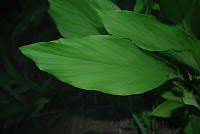Before Aji-No-Moto, the dishes still tasted great and a lot of it is due to the freshness of the ingredients and also the herbs and natural seasonings used. At the farm and at home, we use the various herbs grown at the farm. All these herbs have all kinds of well-being benefits without thinking of them as health food but as mere tasty seasonings. Often at the market, I am asked how do you use them as seasoning so here is a summary of how I have used them:
- Kemangi or Lemon Basil
With the natural lemony aroma and taste, I have used this in:

- the creation of salad dressings such as chopped kemangi leaves with olive oil, salt and pepper and if you want a zing to it, add some chopped chillies,
- coconut-based gravy dishes (masak lemak) that includes seafood and/or fish - just add a few leaves
- chopped and mixed with olive oil and added to pasta
- seasoning for a marinate for chicken (baked or fried) and for fish and crustaceans - you can either blend it or pound it with a mortar and pestle with other ingredients
- Holy Basil or Ruku / Selasih Hitam
It has a creamy taste with a touch of aniseed. Some ways are:

- chicken marinate prepared similar to kemangi leaves
- in savoury dishes such as Asam Pedas on its own or in combination with Kemangi leaves
- chopped and mixed with olive oil and added to pasta
- Lemon grass or Serai
With its slightly spicy lemony taste, it complements many dishes and also as a refreshing drink:

- Condiment/seasoning to many savoury dishes such as Asam Pedas, and coconut-based gravy dishes.
- In combination with other ingredients to create a marinate for fish, seafood or chicken
- Seasoning for steaming or boiling seafood such as cockles, clams, shrimps, crabs, etc.
- Ginger Torch Flower or Bunga Kantan
.JPG)
- Definitely an important ingredient for Asam Pedas and Laksa
- Condiment for Nasi Kerabu
- Chopped and added to olive oil with salt and pepper for a salad dressing
- Selasih Putih
With its slightly creamy taste with a twist, it has a subtle taste. As such, I think that it can be used in many ways but I have only tried it as:
- an ingredient as a marinate for chicken and beef
- a seasoning in coconut-based gravy dishes
- Curry leaves or Daun Kari

- An important ingredient in making curries to give it that extra tastiness
- As a seasoning in creating a spicy fried chicken or ayam goreng berempah.
- The young leaves can be chopped and added to olive oil oil for a "spicy" salad dressing
- Suren leaves or Daun Surian

- As a seasoning for coconut-based gravy dishes that uses young jackfruit, bamboo shoots or young bananas
- As a condiment to reduce the bitterness of dishes that use papaya shoots and flowers
- Tumeric or Kunyit

- The tumeric leaves is used as a seasoning in spicy dishes of chicken and beef such as rendang
- Chopped tumeric leaves along with the fresh pounded tumeric root as a marinate for chicken or beef
- Fresh tumeric root pounded and used in coconut-based gravy vegetable or meat based dishes to create a masak lemak kuning.
- Ginger or Halia
- Used as a seasoning in many coconut-based gravy dishes of seafood, chicken or beef
- As a seasoning in soups
- Pounded or blended with other herbs to create a marinate for chicken, beef and seafood
- As a seasoning in rice prorridge
- Galangal or Lengkuas

- Used as a seasoning in making rendang
- Pounded and added to other herbs to create a marinate for chicken and beef
- Used as a seasoning in coconut-based gravy dishes featuring chicken or beef
- Coriander or Ketumbar
This highly fragrant leave gives the extra "oomph"

- Chopped leaves with olive oil, lemon, salt and pepper for a light salad dressing
- Chopped and used or its own or added to other herbs with salt to create a marinate for meats like chicken and beef which can then be fried or grilled
- As a seasoning for rice porridge.
- As a seasoning for soup dishes.
What I have listed are some suggestions. You can be as creative as you like once you get to know them, the options are endless. My adventure is just beginning and I hope to uncover others to add to my recipes list.



.JPG)






i have a lot of Selasih Putih plant at home but never try used it in cooking before. Sure will be trying it soon.
ReplyDeletep/s : My turmeric plant very frequent producing flower, a friend of mine said it can be used as ulam, is it correct?
satya
http://chitty-boy.blogspot.com
Yes, some people have eaten the tumeric flower as ulam. As a note, when the tumeric has flowered, it means that the tumeric plant is mature and is a great time to dig out the roots and use them. You can them select portions of the root for replanting.
Delete